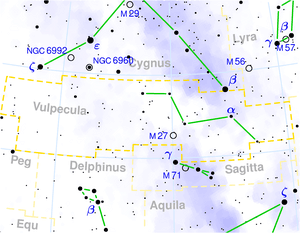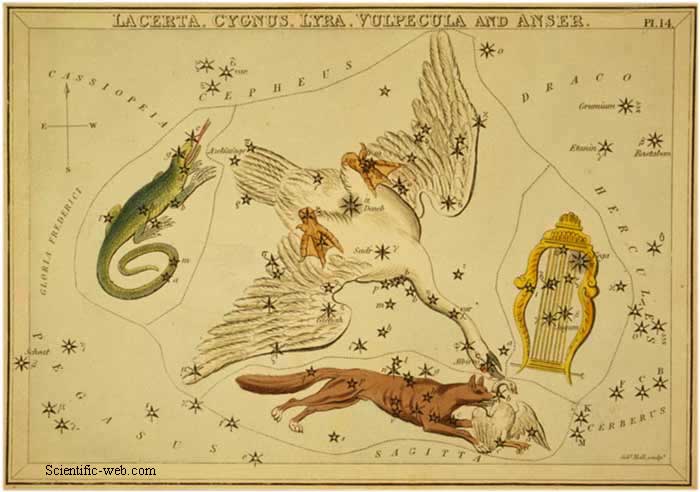- The Deep Photographic Guide to the Constellations: Vulpecula
- Vulpecula page at SEDS (Students for the Exploration and Development of Space)
- M-27 page at SEDS
- Star Tales - Vulpecula
|
|
Vulpecula ( Latin for "little fox") is a faint northern constellation located in the middle of the Summer Triangle (an asterism consisting of the bright stars Deneb, Vega and Altair). Notable features There are no stars brighter than 4th magnitude in this constellation. The brightest star in Vulpecula is α Vulpeculae, a magnitude 4.44m red giant at a distance of 297 light-years. The star is an optical binary (separation of 413.7") that can be split using binoculars. The star also carries the traditional name Anser, which refers to the goose the little fox holds in its jaws. In 1967, the first pulsar, PSR B1919+21, was discovered in this little constellation by Antony Hewish and Jocelyn Bell, in Cambridge. While they were searching for scintillation of radio signals of quasars, they found a very regular signal consisting of pulses of radiation at a rate of one every few seconds. Terrestrial origin of the signal was ruled out because the time it took the object to reappear was a sidereal day instead of a solar day. This anomaly was finally identified as the signal of a rapidly rotating neutron star. The pulses arrive every 1.3373 seconds — too regular to be associated with any other object. Vulpecula is also home to HD 189733 b, the closest extrasolar planet currently being studied by the Spitzer Space Telescope. On 12 July 2007 the Financial Times (London) reported that the chemical signature of water vapour was detected in the atmosphere of this planet. Although HD 189733b with atmospheric temperatures rising above 1 000 °C is far from being habitable, this finding increases the likelihood that water, an essential component of life, would be found on a more Earth-like planet in the future. Notable deep sky objects Two well-known deep sky objects can be found in Vulpecula. The Dumbbell Nebula (M27), is a large, bright planetary nebula which was discovered by the French astronomer Charles Messier in 1764 as the very first object of its kind. It can be seen with good binoculars in a dark sky location, appearing as a dimly glowing disk approximately 6 arcminutes in diameter. A telescope reveals its double-lobed shape, similar to that of an hourglass. Brocchi's Cluster (Collinder 399) is an asterism formerly thought to be an open cluster. It is also called "the Coathanger" because of its distinctive star pattern when viewed with binoculars or a low power telescope. History In the late 17th century the astronomer Johannes Hevelius created this constellation. It was originally known as Vulpecula cum ansere = "the little Fox with the Goose" or Vulpecula et Anser = "the little Fox and the Goose". Hevelius didn't regard Vulpecula and Anser to be two separate constellations, but later the stars were actually subdivided into a separate Anser and a Vulpecula. The Goose, which was represented in the jaws of the Fox, is no longer officially in the sky but remains in the name of star α Vulpeculae: Anser. The name Vulpecula correctly means "little fox", but the translation "Fox" is widely used. Since it was invented in the 17th century, from faint stars, there is no earlier mythology associated with the constellation Vulpecula. References * Ian Ridpath and Wil Tirion (2007). Stars and Planets Guide
Retrieved from "http://en.wikipedia.org/"
|
|
|||||||||||||||||||||||||||||||||||||||||||



